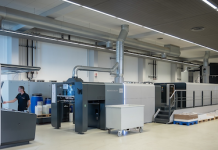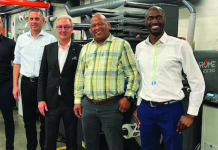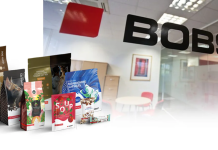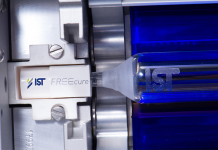The flexo printing unit is designed for applying patterns to non-woven disposable sanitary napkins. Customised to the specifications of the production line, the printing unit comprises up to four water-based colours, a hot air dryer and, at the embossing point, a register guidance camera.
It is capable of printing on non-woven materials between 15 and 22gsm, especially pre-perforated PE polymers. The unit also offers a compact footprint and an operator-friendly design.
Located at point of embossing, the register guidance system ensures synchronisation of the printed pattern with the crease in the centre of the napkin, at speeds of up to 400 metres per minute (approximately 2000 pieces per minute). Using the converting machine interface signals as point of reference, the control module influences the servo motors to ensure accuracy is maintained on-the-fly throughout the production run. Servo drives ensure automatically controlled, precise print speed and ink flow, so that operation without in-house flexo experience or handling is possible.
Allan Sander, vice-president, TRESU Solutions commented, ‘Consumers are increasingly seeking assurance about the quality of their products, and research has shown that there is stronger loyalty to napkin brands with recognisable printed designs such as icons or logos, printed on the fabric. TRESU’s customised printing integration system enables the personal hygiene industry to achieve this, while maintaining a cost-controlled, flexible, single-pass operation.’
The integration unit includes TRESU’s F10 iCon ink supply system with automatic cleaning, to constantly feed the printing units and maintain optimum viscosity, temperature and pressure. Sealed, pressure-controlled chambered doctor blade systems enable direct, foam-free transfer of ink or coating to the anilox rollers, ensuring a consistently clean printed image.
The system is optimised for fast job changes. A control system stores and, in the case of repeat jobs, instantly recalls job recipes, so no re-entry of ink and calibration data is needed. At the installation stage, the TRESU technical team works with the customer to build a unique database of recipe settings for each job, including, among others, impression settings, print levels, flow rate, air velocity, temperature, and register coordinates.
The ability to seamlessly integrate the printing operation into the existing converting and assembly line means that customers can avoid the costs and lengthy lead times associated with outsourcing.
‘TRESU collaborated closely with the customer’s research and development division at every step from the concept stage, to customise the machine to suit production requirements and skills levels,’ stated Sander. ‘The projects have been a large success for the customers, with integrations of our high level printing technology into a large number of hygiene converting lines at locations in Europe, USA, and Mexico,’ he added. ‘From TRESU’s perspective, we are proud to have developed the requested solution on time despite demands on safety, process technology and a tight time frame.’





















